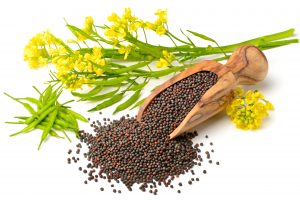Written by: Dr. Jacquie Jacob, University of Kentucky

Canola is a variety of rapeseed that has an oil low in glucosinolates and that produces a meal that is low in eruric acid. The name “canola” was coined to distinguish the variety from rapeseed, though in Europe canola is often referred to as “double-zero” rapeseed. Canola meal is a by-product of the oil extraction process. In oil production, the majority of canola is solvent extracted. In contrast, the extraction method that yields double-pressed canola meal is mechanical, a requirement for organic feedstuffs. Mechanical extraction is not as efficient as solvent extraction, so the meal produced from double-pressed canola is higher in fat than the meal produced by solvent extraction.
The use of canola meal has historically been limited by the meal’s low available protein and energy contents relative to the more commonly used soybean meal (SBM). The main factor affecting nutrient availability is the fibrous hull of the canola seed. The hulls are poorly digested by poultry and dilute the levels of available crude protein and energy. Canola meal also contains nonstarch polysaccharides (NSPs) and glucosinolates, which reduce nutrient availability and break down into toxic aglucons. There are a number of glucosinolates, each of which breaks down into different products.
NUTRIENT CONTENT
The crude protein content of canola meal (36% to 39%) is lower than that of SBM (44% to 48%). Canola meal has a good amino acid profile. As with other vegetable protein sources, canola meal is limiting in lysine but has high levels of methionine and cystine. The digestibilities of the essential amino acids in canola meal, however, are lower than those of SBM. If these reduced digestibilities are taken into consideration, and the diets are formulated on the basis of the digestible amino acids, it is possible to include high levels of canola meal in poultry feeds.
Note that the nutrient profile of canola meal varies from country to country because of differences in oil extraction techniques. Mechanically extracted canola meal contains approximately 32% more energy than solvent extracted meal. As a result, mechanically extracted canola meal can be used in poultry diets as the sole source of protein without the need for additional fat.
USE IN POULTRY DIETS
The list below outlines the recommended inclusion levels of canola meal in different poultry diets:
- Chick starter: Maximum inclusion of 20%
- Broiler grower diets: Maximum of 30% because of no data beyond 30% inclusion
- Turkey grower diet: Maximum inclusion of 20%
- Egg-layer diets: Maximum of 20%
- Breeder diets: Maximum of 30%
- Duck and goose diets: Maximum of 15% because of no data beyond 15% inclusion
As long as it is part of a diet formulated on the basis of digestible amino acids, canola meal can make up as much as 30% of the content in a broiler diet without negatively influencing growth rate and feed efficiency. The lower energy content of canola meal in comparison to SBM has often limited the use of canola meal in high-energy broiler feeds.
Canola meal can be included in turkey diets as long as extra animal fat is added to bring up the energy level of the diet, and the diet is formulated on the basis of available amino acid. Canola meal can also be fed to ducks and geese, as long as the same considerations are taken as for broilers and turkeys.
Canola meal is most commonly used in diets for laying hens. In the past, the inclusion of canola meal in layer diets was limited to less than 10% of the content. This was because of a low but significant level of liver hemorrhage mortality that occurred with higher levels of inclusion. This appeared to be due to residual glucosinolates in the early varieties of canola. Plant breeding has steadily reduced the level of glucosinolates. Canola meal can make up as much as 20% of the content in diets for laying hens with no increase in the incidence of liver hemorrhagic mortality.
The hulls are also a limiting factor in feeding canola meal to poultry because the hulls tend to stick to the inside of the digestive tract. If the digestive tract is torn during processing, the black canola hulls can stick to the carcass, causing it to be downgraded. A solution to this problem is to remove canola meal from the diet five days before processing.
Care must be taken when including canola meal in the diets of brown egg layers because of an increase in fishy flavor that results in the eggs. This appears to be due to reduced levels in brown egg layers of the enzyme needed to break down one of the glucosinolates, trimethylamine. Canola contains high levels of choline and sinapine, precursors of trimethylamine. The presence of tannins in canola also inhibits the enzyme. Breeding programs are making progress in selecting for brown egg layers that do not have this defect.
FOR MORE INFORMATION
Canola meal feed industry guide (Canola Council)

